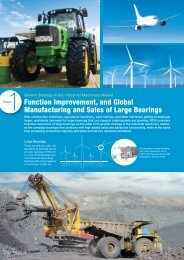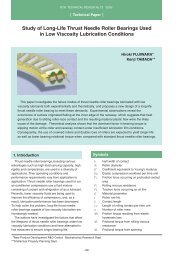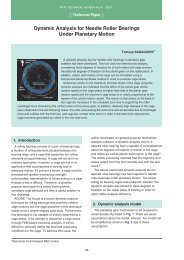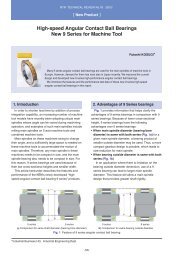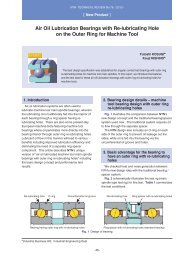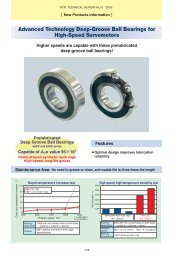Special Issue; Products for Industrial Machinery - NTN
Special Issue; Products for Industrial Machinery - NTN
Special Issue; Products for Industrial Machinery - NTN
Create successful ePaper yourself
Turn your PDF publications into a flip-book with our unique Google optimized e-Paper software.
<strong>NTN</strong> TECHNICAL REVIEW No.742006<br />
Technical Paper <br />
Atmospheric Control Method <strong>for</strong> JIS-SUJ2<br />
Carbonitriding Processes<br />
Chikara OHKI<br />
<strong>NTN</strong> has been investigating the mechanism of nitrogen<br />
penetration into JIS-SUJ2 bearing steel during carbonitriding<br />
processes. In the course of carbonitriding experiments under<br />
various conditions and Electron Probe Micro Analysis (EPMA)<br />
analysis, the influences of carbon activity and base gas<br />
components on nitrogen penetration behavior were examined. As<br />
a result, the nitrogen penetration content of steel increased with<br />
an increase in undecomposed NH3 partial pressure and with an<br />
decrease in carbon activity, and H2 partial pressure.<br />
Assuming that the penetration mechanism of nitrogen is similar<br />
to that of carbon, a calculation method was developed in order to<br />
estimate nitrogen concentration distribution profiles. It was<br />
confirmed that the nitrogen concentration distribution profiles<br />
predicted by <strong>NTN</strong>'s method agreed well with the experiment<br />
results under various conditions. Hence, a development of a new<br />
atmosphere control method <strong>for</strong> JIS-SUJ2 carbonitriding<br />
processes was achieved.<br />
1. Introduction<br />
Carbonitriding processes are heat treatment<br />
techniques that are often used to improve the fatigue<br />
strength of steel materials. There are many<br />
applications <strong>for</strong> using carbonitriding techniques on<br />
bearing steels. In particular, it has been verified that<br />
carbonitriding bearing steel materials contribute to<br />
longer bearing life under contaminated lubrication<br />
conditions. 1)<br />
The carbon penetration mechanism that takes place<br />
during carburizing is understood. In contrast, although<br />
there has been active research on the nitrogen<br />
penetration mechanism in carbonitriding processes, 2)<br />
there has been little research on nitrogen penetration<br />
in carbonitriding processes <strong>for</strong> high carbon steels<br />
(including bearing steel). To address this, <strong>NTN</strong> has<br />
systematically per<strong>for</strong>med a series of carbonitriding<br />
experiments <strong>for</strong> JIS-SUJ2 bearing steel in an attempt<br />
to clarify the nitrogen penetration mechanism.<br />
3) 4)<br />
2. Test Methods<br />
2.1 Experimental furnace and furnace<br />
atmosphere measuring method<br />
For the series of experiments per<strong>for</strong>med, a batchtype<br />
heat treatment furnace (capacity 120 L) was<br />
used. During carbonitriding processes, the<br />
atmosphere was analyzed by the equipment<br />
summarized in Table 1. The furnace itself is<br />
schematically illustrated in Fig. 1 and the base gas<br />
feeder is shown in Fig. 2.<br />
2.2 Material tested and method <strong>for</strong> measuring<br />
nitrogen concentration<br />
The material used <strong>for</strong> the test was a JIS-SUJ2 high<br />
carbon chromium bearing steel. The chemical<br />
components of the material are summarized in Table 2.<br />
The test pieces were ring-shaped with dimensions of 30<br />
ID x 38 OD x 10 T (mm).<br />
Nitrogen concentration distributions of the test<br />
Elemental Technological R&D Center<br />
-44-


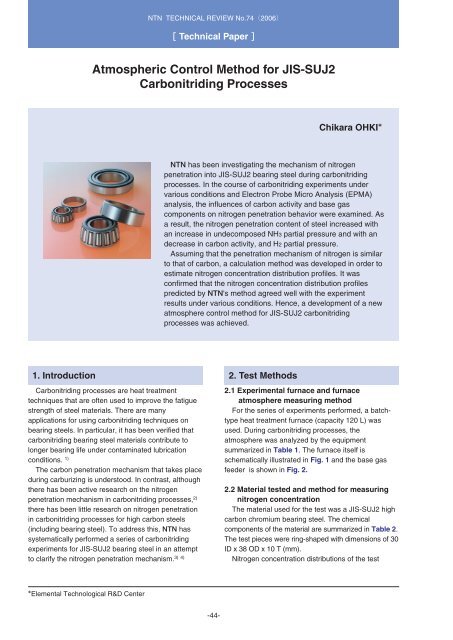
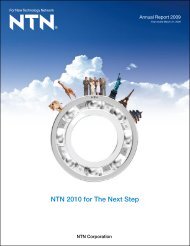
![[New Product] Unit Products for Office Equipment - NTN](https://img.yumpu.com/27154451/1/184x260/new-product-unit-products-for-office-equipment-ntn.jpg?quality=85)
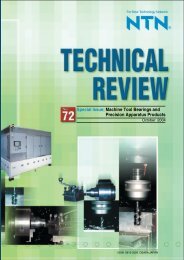
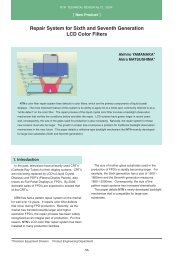
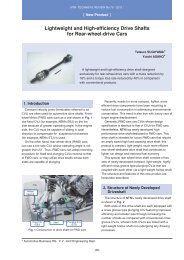
![[New Product] Development of Oil-impregnated Sintered ... - NTN](https://img.yumpu.com/27154427/1/184x260/new-product-development-of-oil-impregnated-sintered-ntn.jpg?quality=85)

